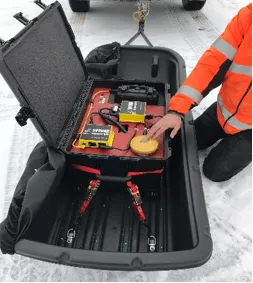Ground Penetrating Radar Helps Ensure Safe Travel on Alaska’s Ice Roads
On the southwest coast of Alaska, the Yukon-Kuskokwim region is home to around 25,000 people and growing. The region depends on a unique transportation network that includes very few roads. The transportation, services, supplies, and administrative hub for over 50 villages is Bethel, the eighth-largest city in Alaska. Bethel is located about 50 miles upriver from where the Kuskokwim River empties into the Bering Sea, and is accessible by river and air only.
Each year when the rivers freeze over, crews from nine villages along the Kuskokwim and Johnson Rivers work tirelessly to keep the local ice roads clear and safe. An ice road is a winter road, or part thereof, that runs on a naturally frozen water surface such as a river or an expanse of sea ice. Ice roads provide a temporary means of transportation in isolated areas with no permanent road access. Local crews must continuously monitor ice thickness and quality and clear blown snow to ensure that those who travel over the frozen waterways via snowmobile or other vehicle type can do so safely. In addition to citizens and commercial delivery services, a wide array of government services use the ice road, including U.S. mail contractors, Alaska State Troopers, medical transports, school systems, and search and rescue emergency services (see photos).
Alaska’s ice roads are an important means of transportation during the winter, making it possible for residents to receive deliveries of fuel, firewood, and supplies. One project taking place this past March was delivery of fuel to a village that was operating on emergency rations. Because the ice did not become thick enough during the winter to support delivery of fuel by tanker truck, the fuel delivery company arranged for a fleet of smaller fuel trucks to deliver the fuel by following a path scouted by ice road experts from the Native Village of Napaimute.
Ground Penetrating Radar within an enclosed hard plastic container pulled by a sled.
Ground penetrating radar sled used to monitor ice road thickness
Utilizing a grant from the Tribal Transportation Program Safety Fund, the ice roads crew from the Native Village of Napaimute acquired new technology that is now being used in combination with traditional knowledge to help monitor ice thickness. The device uses ground penetrating radar (GPR) and GPS technology to constantly measure and record ice thickness (see photo at right). As the device is towed on a sleigh, the measurements are wirelessly transmitted to an in-cab computer, which generates nearly instantaneous reports from the data. After about a mile of monitoring, the radar device requires calibration, which is performed by drilling a hole in the ice just large enough to measure ice thickness with a tape measure. The depth of the hole is then recorded in a computer, which adjusts the depth reported in further readings.
This past winter saw unprecedented warm weather, resulting in unusually thin, weak ice. In addition, open holes, usually smaller than 20 inches in diameter, are appearing in the ice. These holes, whose cause is unknown, are unlike anything previously seen by those with decades of experience on the ice roads. Mark Leary, Director of Development & Operations at the Native Village of Napaimute, theorized that these holes could be the results of pockets of methane gas being trapped as permafrost melts.
The use of this new GPR technology has made it possible for maintenance crews to warn travelers of the locations of thin ice, holes, or other areas where travel should be avoided. While similar devices have been used in Canada, where ice roads with limited river crossings are more common, the Kuskokwim ice road is different in that it runs over 120 miles of river rather than simply crossing water over short distances.
The GPR is especially important when heavy loads are being moved, enabling consistent monitoring of the ice road thickness over 1-mile segments. Prior to obtaining the GPR device, maintenance crews could only drill intermittently to estimate ice thickness, and thin areas could only be identified if the crew was lucky enough to drill in that spot. GPR also provides good data, helping local maintenance crews determine when it’s safe to start using the ice road as well as when ice road travel should stop.

Demonstration of the process to calibrate the ground penetrating radar device. Adam Larsen, of the FHWA Office of Tribal Transportation within the Office of Federal Lands Highway, operates the drill and measures ice thickness while Mark Leary, from the Native Village of Napaimute, records the results.
Adapting to changing climate means adapting the operation of the ice roads and continuing to learn and innovate in order to ensure safe winter travel in one of the world’s harshest environments. Advances in research and constantly evolving technology may be able to help increase the safety, frequency, and accuracy of the processes used to monitor ice quality and thickness.
“By combining our traditional knowledge with new technology we are able to manage safe travel despite a changing climate that produces less ice,” said Leary.
Despite the many advances made in recent years, gaps in both technology and our understanding of the mechanical properties of ice roads exist, and research is needed to ensure that the use of ice roads can remain as safe as possible. For example, there is a need for methods to test the strength of ice samples and calculate the load that can be carried by ice of varying thickness. Exploring the use of drone photography, drone thermal imagery, sonar, radar, or other technology to screen ice roads for hazardous conditions such as thin ice, open water, and open water covered by snow will also help save lives by ensuring safe transportation in a difficult climate during severe winter conditions.
For more information about the Tribal Transportation Program that funded this technology, please contact Adam Larsen at adam.larsen@dot.gov.

